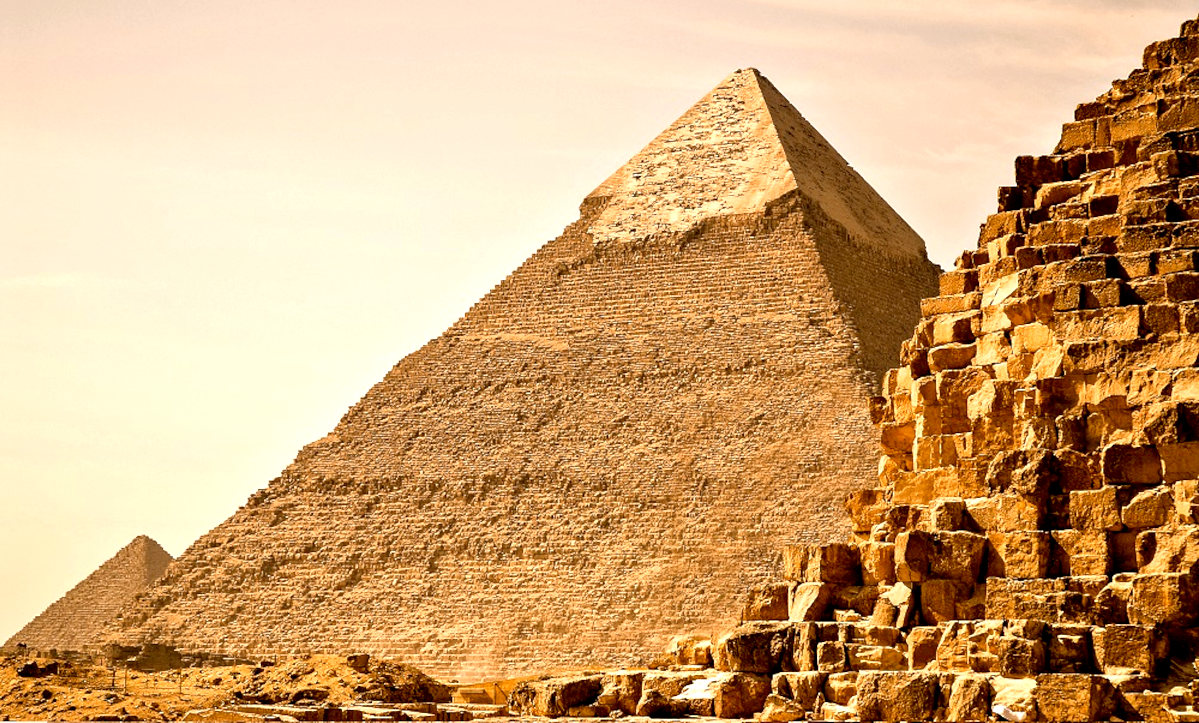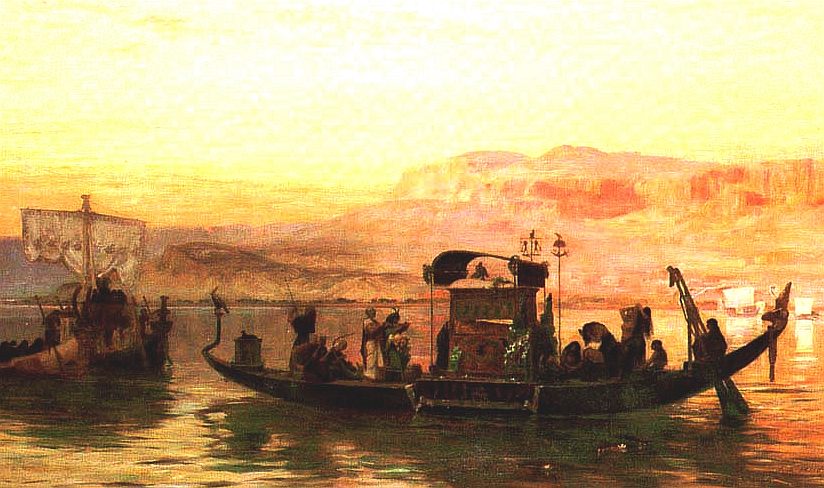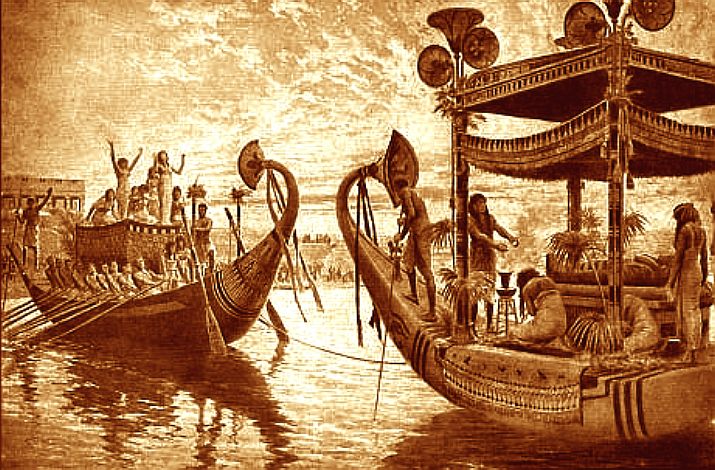
The
Egyptian rulers built giant mausoleums called Pyramids,
and other large monumental statues, such as the
Great Sphinx at Giza.
The bigger the pyramid, the more important the deity. As
their Gross National Product reduced, so too did the size of
their mausoleums.
For almost 30
centuries - from its unification around 3100 B.C. to its conquest by
Alexander the Great in 332 B.C.
- ancient Egypt was the preeminent civilization in the Mediterranean world.
The main sources of information about ancient Egypt are the many monuments, objects and artifacts that have been recovered from archaeological sites, covered with hieroglyphs that have only recently been deciphered. The picture that emerges is of a culture with few equals in the beauty of its art, the accomplishment of its architecture or the richness of its religious traditions.
Ancient Egypt can be thought of as an oasis in the desert of northeastern Africa, dependent on the annual inundation of the
Nile River to support its
agricultural
population. The country’s chief wealth came from the fertile floodplain of the
Nile valley, where the river flows between bands of limestone hills, and the Nile delta, in which it fans into several branches north of present-day
Cairo. Between the floodplain and the hills is a variable band of low desert that supported a certain amount of game. The Nile was Egypt’s sole transportation artery.
What
lost treasures might we discover as the mysteries of the
ancients unfold. Televised
documentary programmes have done a great deal to make
history come to life. The search continues for more answers,
digging amongst the sands and diving around the shores.
INTERESTING FACTS ABOUT ANCIENT EGYPT
1. CLEOPATRA WAS NOT EGYPTIAN
Along with King Tut, perhaps no figure is more famously associated with ancient Egypt than
Cleopatra
VII. But while she was born in Alexandria, Cleopatra was actually part of a long line of Greek Macedonians originally descended from Ptolemy I, one of Alexander the Great’s most trusted lieutenants. The
Ptolemaic Dynasty ruled Egypt from 323 to 30 B.C., and most of its leaders remained largely Greek in their culture and sensibilities. In fact, Cleopatra,
Queen
of the Nile, was famous for being one of the first members of the Ptolemaic dynasty to actually speak the Egyptian language.
2. SACRED ANIMALS
Cats were considered sacred animals by the Ancient Egyptians. It’s thought that most families kept a cat as a pet, which they believed would bring the household good luck. Harming a cat attracted harsh penalties for the
perpetrator.
3. INNOVATORS
The Ancient Egyptians invented lots of things we still use today, such as paper, pens, locks and keys and even; toothpaste. The colour blue was developed by the Egyptians.
Early chemical batteries may have been a thing, but for what
purpose is not known.
4. THE EARLIEST PEACE TREATY ON RECORD
For over two centuries the Egyptians fought against the Hittite Empire for control of lands in modern day Syria. The conflict gave rise to bloody engagements like 1274 B.C.’s Battle of Kadesh, but by time of the pharaoh Ramses II neither side had emerged as a clear victor. With both the Egyptians and Hittites facing threats from other peoples, in 1259 B.C. Ramses II and the Hittite King Hattusili III negotiated a famous peace treaty. This agreement ended the conflict and decreed that the two kingdoms would aid each other in the event of an invasion by a third party. The Egyptian-Hittite treaty is now recognized as one of the earliest surviving peace accords, and a copy can even be seen above the entrance to the
United Nations Security Council Chamber in New York.
5. THEY LOVED BOARD GAMES
After a long day’s work along the Nile River, Egyptians often relaxed by playing board games. Several different games were played, including “Mehen” and “Dogs and Jackals,” but perhaps the most popular was a game of chance known as “Senet.” This pastime dates back as far as 3500 B.C. and was played on a long board painted with 30 squares. Each player had a set of pieces that were moved along the board according to throwing sticks (in the same way we throw dice) to see how many squares to move your piece forward on the board. Historians still debate Senet’s exact rules, but there is little doubt of the game’s popularity. Paintings depict
Queen Nefertari playing Senet, and pharaohs like Tutankhamen even had game boards buried with them in their tombs.
Senet, was played for over 2,000 years!
6. ANCIENT EGYPTIAN WOMEN ENJOYED MANY HUMAN RIGHTS
While they may have been publicly and socially viewed as inferior to men, Egyptian women enjoyed a great deal of legal and financial independence. They could buy and sell property, serve on juries, make wills and even enter into legal contracts. Egyptian women did not typically work outside the home, but those who did usually received equal pay for doing the same jobs as men. Unlike the women of ancient Greece, who were effectively owned by their husbands, Egyptian women also had the right to divorce and remarry. Egyptian couples were even known to negotiate an ancient prenuptial agreement. These contracts listed all the property and wealth the woman had brought into the marriage and guaranteed that she would be compensated for it in the event of a divorce.
7. EGYPTIAN WORKERS ORGANIZED LABOUR STRIKES
Even though they regarded the pharaoh as a kind of living god, Egyptian workers were not afraid to protest for better working conditions. The most famous example came in the 12th century B.C. during the reign of the New Kingdom pharaoh Ramses III. When laborers engaged in building the royal necropolis at Deir el-Medina did not receive their usual payment of grain, they organized one of the first recorded strikes in history. The protest took the form of a sit-in: The workers simply entered nearby mortuary temples and refused to leave until their grievances were heard. The gamble worked, and the laborers were eventually given their overdue rations.
8. PYRAMIDS WERE TOMBS FOR PHARAOHS
Most Ancient Egyptian pyramids were built as tombs for pharaohs (rulers of Ancient Egypt) and their families. To date, over 130 pyramids have been discovered in Egypt.
9. THE AFTERLIFE WAS IMPORTANT TO THE EGYPTIANS
Much as with Christianity and going to heaven or hell. The Egyptians believed that by preserving a dead person’s body – which they did through the process of
mummification – their soul would live on in the
afterlife forever.
10. PHARAOHS WERE OFTEN OBESE
Egyptian art commonly depicts pharaohs as being trim and statuesque, but this was most likely not the case. The Egyptian diet of beer, wine, bread and honey was high in sugar, and studies show that it may have done a number on royal waistlines. Examinations of mummies have indicated that many Egyptian rulers were unhealthy and overweight, and even suffered from diabetes. A notable example is the legendary
Queen Hatshepsut, who lived in the 15th century B.C. While her sarcophagus depicts her as slender and athletic, historians believe she was actually obese and balding.
11. THE PYRAMIDS WERE NOT BUILT BY SLAVES
The life of a pyramid builder certainly wasn’t easy -
skeletons of workers commonly show signs of arthritis and other
ailments - but evidence suggests that the massive tombs were built not by slaves but by paid laborers. These ancient construction workers were a mix of skilled artisans and temporary hands, and some appear to have taken great pride in their craft. Graffiti found near the monuments suggests they often assigned humorous names to their crews like the “Drunkards of Menkaure” or the “Friends of Khufu.” The idea that slaves built the pyramids at the crack of a whip was first conjured by the Greek historian Herodotus in the fifth century B.C., but most historians now dismiss it as myth. While the ancient Egyptians were certainly not averse to keeping slaves, they appear to have mostly used them as field hands and domestic servants.
In the modern world, most people are financial slaves to
banks and kleptocrats.
12. KING TUT MAY HAVE DIED IN A HUNTING ACCIDENT
Surprisingly little is known about the life of the boy pharaoh
Tutankhamun, but some historians believe they know how he died. Scans of the young king’s body show that he was embalmed without his heart or his chest wall. This drastic departure from traditional Egyptian burial practice suggests that he may have suffered a horrific injury prior to his death. According to a handful of Egyptologists, one of the most likely causes for this wound would have been a bite from a
hippopotamus. Evidence indicates that the Egyptians hunted the beasts for sport, and statues found in King Tut’s tomb even depict him in the act of throwing a
harpoon. If the boy pharaoh was indeed fond of stalking dangerous game, then his death might have been the result of a hunt gone wrong.
13. DENTISTS & OPTICIANS
An ancient physician was usually a jack-of-all-trades, but evidence shows that Egyptian doctors sometimes focused on healing only one part of the human body. This early form of medical specialization was first noted in 450 B.C. by the traveler and historian Herodotus. Discussing Egyptian medicine, he wrote, “Each physician is a healer of one disease and no
more … some of the eye, some of the teeth, some of what pertains to the belly.” These specialists even had specific names. Dentists were known as “doctors of the tooth,” while the term for proctologists literally translates to “shepherd of the anus.”
14. WEIGHTY STUFF
The Pyramid of Khufu at Giza is the largest Egyptian pyramid. This incredible structure weighs as much as
sixteen Empire State buildings.
15. IT'S A WRAP
Unwrapped, the bandages of an Ancient Egyptian mummy could stretch for 1.6km.
The cloth was sometimes treated with preservative.
16. HIEROGLYPHICS
The Egyptian alphabet contained more than 700 hieroglyphs, the meaning of some of which is still open to interpretation.
17. WORSHIP
Ancient Egyptians believed in more than 2,000 deities! They had gods for everything, from dangers to chores! Each had different responsibilities and needed to be worshipped so that life could be kept in balance.
18. PETS R US
The Egyptians saw animals as incarnations of the gods and were one of the first civilizations to keep household pets. Egyptians were particularly fond of
cats, which were associated with the goddess Bastet, but they also had a reverence for
hawks, ibises,
dogs,
lions and baboons. Many of these animals held a special place in the Egyptian home, and they were often mummified and buried with their owners after they died. Other creatures were specially trained to work as helper animals. Egyptian police officers, for example, were known to use dogs and even trained
monkeys to assist them when out on patrol.
19. UNISEX (HEALING) MAKEUP
Vanity is as old as civilization, and the ancient Egyptians were no exception. Both men and women were known to wear copious amounts of makeup, which they believed gave them the protection of the gods
Horus and
Ra. These cosmetics were made by grinding ores like malachite and galena into a substance called kohl. It was then liberally applied around the eyes with utensils made out of wood, bone and ivory.
The eye paint was usually green (made from copper) or black (made from lead).
Women would also stain their cheeks with red paint and use henna to color their hands and fingernails, and both sexes wore perfumes made from oil, myrrh and cinnamon. The Egyptians believed their makeup had magical healing powers: Research has shown that the lead-based cosmetics worn along the Nile actually helped stave off eye infections.
20. LONGEST RIVER
The river Nile is the longest river in the
world at 4,132 miles long. It flows from Lake Victoria in East Africa up north through the Sahara Desert and finally drains in the
Mediterranean
Sea.

WHAT HAPPENED TO THE EMPIRE?
History shows that even the mightiest empires can fall and after 1,100 BC, Egypt went into decline. There were several reasons for this including a loss of military power, lack of natural resources, and political conflicts.
The reigns of the last great pharaohs Ramses II and Ramses III (1,189 BC to 1,077 BCE) are characterized by strength and ability to defend Egypt against invaders. However, it took significant manpower and resources to ward off these continual attacks and these defenses left the economy’s empire struggling.
Egypt experienced a civil war and remained split between two regions. This left it vulnerable to further invasions and control from the Assyrians in 671 BCE, the Persians in 525 BCE and finally the Greeks in 332 BCE.
At the end of Egypt’s empire the climate became erratic and unstable. The Egyptians relied on the
water from the Nile floods to help their crops grow, but the Egyptian
climate experienced roughly a hundred of years of dry spells and water became scarce.
There were also periods of unusually cold weather that further stressed the crops and led to a drastic decrease in harvests. Crops were also destroyed by sporadic and unpredictable flooding of the Nile. With little to no food or surplus for long periods of time,
hunger and famine spread.
Economic and political unrest also led to the weakening of the Ancient Egyptian empire. There were huge inequalities in the distribution of wealth among the elites and the rest of the
population. Many people began to distrust the government and religious authority. The continuous wars created huge expenses and weakened the economic power of the Pharaoh.
Christianity began to spread through Egypt and brought the adoption of the alphabet instead of hieroglyphics creating major changes in Egyptian culture. Many ancient practices such as
mummification
ended, as being too costly.

Our knowledge of the succession of Egyptian kings is based on kinglists kept by the ancient Egyptians themselves. The most famous are the Palermo Stone, which covers the period from the earliest dynasties to the middle of Dynasty 5; the Abydos Kinglist, which Seti I had carved on his temple at Abydos; and the Turin Canon, a papyrus that covers the period from the earliest dynasties to the reign of Ramesses II. All are incomplete or fragmentary. We also rely on the History of Egypt written by Manetho in the third century B.C. A priest in the temple at Heliopolis, Manetho had access to many original sources and it was he who divided the kings into the thirty dynasties we use today.
It is to this structure of dynasties and listed kings that we now attempt to link an absolute chronology of dates in terms of our own calendrical system. The process is made difficult by the fragmentary condition of the kinglists and by differences in the calendrical years used at various times. Some astronomical observations from the ancient Egyptians have survived, allowing us to calculate absolute dates within a margin of error. Synchronisms with the other civilizations of the ancient world are also of limited use.
Cleopatra's
tomb had not been discovered at time of writing. Yet she is one of the most
famous Pharaohs, ruling as Queen of Egypt more successfully
than her forebears, but her life was short. She had no fear
of poisoning herself, possibly because she knew, that one
day she would be reincarnated, to resume her imperial
agenda. This presupposes that she would have made
arrangements for her body to be preserved for the afterlife.
Very much like in 1999 film: The
Mummy, where Imhotep returns from being mummified, to resurrect
Anck-su-namun.
NOTABLE KINGS
Djoser
Khufu
Khafre
Ahmose
Amenhotp I
Thutmose I, II, III
Ramesses I, II III, VI, VIII, IX, X, XI
Amenhotep II
Akhenaten
Tutankamun
Seti I & II
Alexander the Great
Ptolemy I Soter I
Ptolemy IV Philopator
Ptolemy VI Philometor
Ptolemy IX Soter II
NOTABLE QUEENS
Arsinoe II
Cleopatra I, II
Hatshepsut
Sobekneferu
(Neferusobek)
Nefertiti,
beautiful ancient Egyptian queen, architect of the sun cult
Cleopatra
VII
last queen of Egypt
Amina, queen for 34 years in Nigeria
Candace,
Ethiopian Empress, fearsome fighter who resisted Alexander the
Great
Semiramis,
female ruler Assyrian empire.





